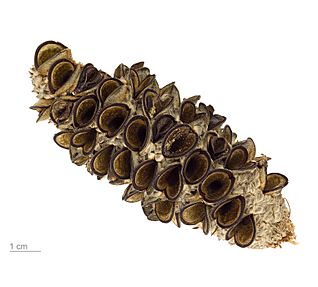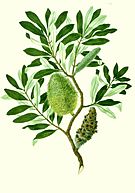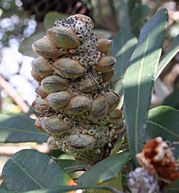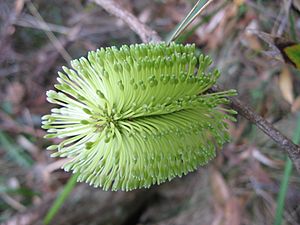Coast banksia facts for kids
Quick facts for kids Coast banksia |
|
|---|---|
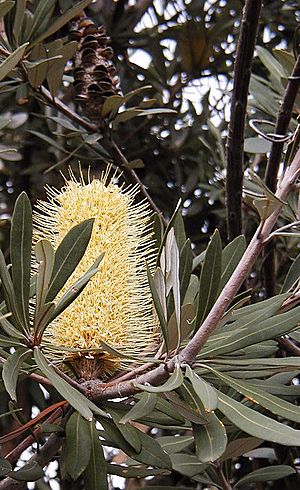 |
|
| Banksia integrifolia subsp. integrifolia | |
| Scientific classification | |
| Genus: |
Banksia
|
| Species: |
integrifolia
|
| Subspecies | |
|
B. integrifolia subsp. integrifolia |
|
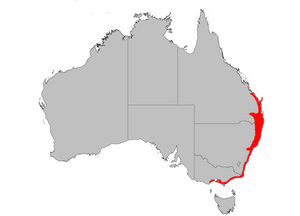 |
|
| B. integrifolia distribution | |
The Banksia integrifolia, often called the coast banksia, is a type of tree that grows along Australia's eastern coast. It's one of the most common Banksia species, found from Victoria all the way to Central Queensland. You can spot it in many different places, from sandy dunes by the sea to high mountains. This tree can look very different depending on where it grows, but it's usually a tree up to 25 metres (82 ft) tall. Its leaves are dark green on top and white underneath, which looks really cool on a windy day!
This banksia was one of the first four Banksia species ever collected by Sir Joseph Banks in 1770. It was also one of the first four species named in 1782 by Carolus Linnaeus the Younger. Over time, scientists have learned a lot about it. Now, we know there are three main types, called subspecies: B. integrifolia subsp. integrifolia, B. integrifolia subsp. compar and B. integrifolia subsp. monticola.
The coast banksia is a tough and useful garden plant. Many people plant it in their gardens, parks, and along streets in Australia. It's also used to help bring back native plants in areas and to stop sand dunes from moving. Because it's so strong, scientists are even looking into using it to help grow other types of flowers for the cut flower trade. However, its toughness also means it could become a weed if it grows outside its natural home.
Contents
What's in a Name?
Today, this tree is widely known as the coast banksia or coastal banksia. But in the past, it had many other common names. Some old names include honeysuckle, white banksia, white bottlebrush, and white honeysuckle. Sometimes, people even called it honeysuckle oak.
Long before Europeans arrived, Indigenous Australians knew this tree well. For example, the Gunai people from Gippsland called it birrna. Since it grows in so many places, it likely had different names in other Indigenous languages, but sadly, many of these names are now lost.
How to Spot a Coast Banksia
The coast banksia can look very different from one tree to another. Most often, it's a tree that grows up to 25 metres (80 ft) tall. In places where it's protected from strong winds, it can even reach 35 metres (110 ft). But in very windy spots, like on coastal cliffs, it might only grow as a small, twisted tree about 5 metres (15 ft) tall, or even just a small shrub.
It usually has one strong trunk that often looks twisted and gnarled. The bark is rough and grey, which is common for Banksia trees. Its leaves are dark green on top and white underneath. They grow in groups of three to five, like a whorl. Adult leaves have smooth edges. Young leaves have a few short teeth and are usually bigger than adult leaves.
The flowers grow in what's called a "flower spike," which is a special type of inflorescence. It's made of hundreds of tiny flowers packed closely together in a spiral shape around a woody stem. This spike is usually about 10 to 12 centimetres (4–5 in) tall and five centimetres (2 in) wide. The flowers are usually pale yellow, but can sometimes be greenish or pinkish when they are still buds.
After the flowers bloom, they dry up and fall off, leaving behind a "cone." This woody cone has many small follicles (seed pods) hidden inside. These follicles start out green and fuzzy, then turn dark grey. Each follicle holds one or two seeds, separated by a thin wooden piece. The seeds are black, about 6 to 10 millimetres (0.2–0.4 in) long, with a feathery black 'wing' that helps them fly in the wind.
The Banksia Family Tree
The B. integrifolia was first found at Botany Bay on April 29, 1770. It was discovered by Sir Joseph Banks and Dr Daniel Solander, who were naturalists on Captain James Cook's ship, the Endeavour. However, it wasn't officially named until April 1782. That's when Carolus Linnaeus the Younger described the first four Banksia species. He named this one integrifolia because its leaves have smooth, "entire" edges. The name comes from the Latin words integer (meaning "entire") and folium (meaning "leaf"). So, its full scientific name is Banksia integrifolia L.f.
For a long time, it was hard for scientists to agree on how to classify this plant because it can look so different. But in 1981, a scientist named Alex George published an important book that helped sort out the Banksia family. Since then, scientists have continued to learn more, and now the way Banksia integrifolia is classified is mostly settled.
Different Types of Coast Banksia
There are three main types, or subspecies, of Banksia integrifolia:
- B. integrifolia subsp. compar
- B. integrifolia subsp. integrifolia
- B. integrifolia subsp. monticola
Even though the environment can make a banksia look different, much of its variety comes from its genetics. Alex George once said that this plant seems to be "actively speciating" to fit into all the different places it grows.
- Banksia integrifolia subsp. integrifolia
- This is the most common type. It grows near the coast in most of the species' range. It doesn't change much, except in northern New South Wales and southern Queensland, where it sometimes looks like a mix with B. integrifolia subsp. compar.
- Banksia integrifolia subsp. compar
- This type grows along the coast in Queensland, reaching as far north as Proserpine. You can tell it apart by its leaves, which are larger, shiny, and have wavy edges.
- Banksia integrifolia subsp. monticola
- This one is also called the white mountain banksia. It's the only type that grows in the mountains, specifically in the Blue Mountains of northern New South Wales. It looks a lot like B. integrifolia subsp. integrifolia, but its leaves are longer and narrower, and its seed pods are more deeply set into the old flower spike.
Friends and Family
Sometimes, B. integrifolia can naturally mix with other Banksia species, creating hybrids. These mixed plants have features from both parent species. For example, hybrids with B. paludosa (swamp banksia) have smaller growth, longer flower spikes, and old flowers that stay on the cones.
You can also find hybrids with B. marginata (silver banksia) in places like Wilsons Promontory in Victoria. These plants are found where both species grow together and show features that are in between the two. One such hybrid is even sold in nurseries as a small, attractive plant that grows to about 1 metre tall.
Where Does it Grow?
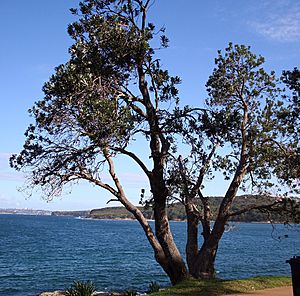
The B. integrifolia is found in many different places across Australia. It grows along almost the entire eastern coast, from Geelong, Victoria up to Proserpine, Queensland. It used to grow on Long Island, Tasmania, but it's no longer found there and is now considered extinct in Tasmania.
For most of its range, the coast banksia grows within about 50 kilometres (30 mi) of the coast. It prefers sandy soils that come from sandstone. You can see it near coastal cliffs, by river estuaries, and on stable sand dunes. The temperature in these areas is usually between 0–30 °C (30–85 °F), with very few frosts. It often grows with other trees like Melaleuca quinquenervia (broad-leaved paperbark) and Angophora costata (smooth-barked apple).
Between Sydney and Brisbane, you can find B. integrifolia much further inland, up to 200 kilometres (125 mi). The B. integrifolia subsp. monticola grows in the Blue Mountains at heights up to 1500 metres (5000 ft). There, it grows in richer volcanic or rocky soils and can experience up to 100 frosts a year. In these mountain areas, it grows alongside Eucalyptus species like E. viminalis (manna gum) and E. pauciflora (snow gum).
At Cape Byron, the most easterly point of mainland Australia, no other tree grows closer to the coast than the B. integrifolia.
Life in the Wild

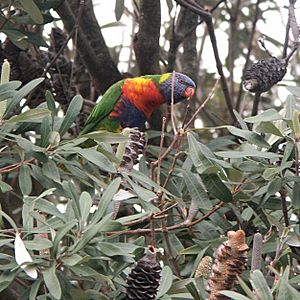
Like most other plants in the Proteaceae family, the B. integrifolia has special roots called proteoid roots. These roots have dense clusters of short side roots that form a mat just under the leaf litter. They help the plant get nutrients from poor soils, like the low-phosphorus soils found in Australia.
The flowers of B. integrifolia don't last very long, only producing nectar for about four to twelve days after they open. Most of the nectar is made at night and early in the morning. This tree flowers all year, but there's a big peak in autumn. Since not many other plants flower then, it's a very important food source for animals that eat nectar. Many animals visit these flowers, including lots of insects, different kinds of birds like the Phylidonyris novaehollandiae and Trichoglossus moluccanus, and even mammals like Petaurus norfolcensis (squirrel glider) and Pteropus poliocephalus (grey-headed flying fox).
Unlike most Banksia species, the B. integrifolia doesn't need a bushfire to release its seeds. Instead, its seeds are released naturally when they are ready in late summer. Even though it doesn't need fire for seeds, some studies have shown that if fires are stopped for many years, the number of these trees can go down. This might be because the soil becomes unhealthy or because young plants face too much competition for water and are eaten by herbivores.
Despite these concerns, the B. integrifolia is not considered to be in danger. It's very good at resisting a plant disease called Phytophthora cinnamomi dieback, which harms many other Banksia species. Also, because it grows in so many places, it's protected from losing its home due to land clearing. So, it's not on the list of threatened flora of Australia.
Growing Your Own Banksia

The B. integrifolia is a tough and adaptable plant. It can grow in clay, sand, acid, and even alkaline soils. It's also good at handling wind and salt, making it perfect for planting near the sea. This makes it a great, easy-to-care-for garden tree. However, because it can grow quite large, it might not be suitable for smaller gardens. Its hardiness means it could become a weed in places outside its natural habitat, like in Western Australia and New Zealand. If you're planting it near natural bushland, it's best to get seeds or plants from your local area.
The most common type you'll find in nurseries is the regular Banksia integrifolia subsp. integrifolia. It likes sunny spots and doesn't do well with frosts. You can prune it quite a bit. Its seeds don't need any special treatment and usually sprout in about 5 to 6 weeks. The tree starts flowering when it's about four to six years old. The other subspecies are not as well known in gardens, but you can find them. They probably grow similarly, but the mountain type, B. integrifolia subsp. monticola, can handle frost. There are also dwarf forms of B. integrifolia available, including a special type called Banksia 'Roller Coaster'. This one is a strong plant that spreads along the ground, growing 4 or 5 metres wide but only 50 centimetres tall.
Because the B. integrifolia is so good at resisting dieback disease, scientists are looking into using it as a base (rootstock) for other Banksia species that are easily affected by the disease. This could help grow more cut flowers. More research is needed to make this method work well for commercial use.
Other Cool Uses
The wood of the B. integrifolia is pink to red. It's spongy and porous, but it tends to warp when it dries and isn't very strong. It's also easily attacked by termites, so it's not good for building houses. However, it's considered very pretty and is sometimes used for cabinet panels or in ornamental woodturning. In the past, people looked for naturally bent pieces of its wood to make boat parts. It also makes good firewood.
The B. integrifolia produces a dark, amber-coloured honey. It's not the best quality for selling, but beekeepers really value it. This is because it makes a lot of pollen and nectar during autumn and winter, which helps feed bee hives when other plants aren't flowering.
Historically, indigenous Australians would get nectar from B. integrifolia by stroking the flower spikes and licking their hands, or by soaking the spikes in a coolamon (a wooden dish) overnight. They also used the flower spikes as hairbrushes! Early settlers used the nectar as a syrup for sore throats and colds. Bushmen would even put fat into the empty "cones" to make slow-burning candles.
More recently, the B. integrifolia has been used in the art of bonsai (growing miniature trees). It can be tricky because it tends to grow long branches, but its leaves can be made smaller with pruning. And unlike some other banksias, its trunk can get a cool texture as it ages.
This tree is also a floral emblem for two areas in Queensland: the City of Redcliffe and the City of Logan. In 2000, it was even featured on an Australian postage stamp.
|


